Mechanical Computers From Then To Now: Greubel Forsey Quantième Perpétuel à Équation
Calculating large numbers is a pain if all you have handy is your brain and a pencil. This is why people have created systems and objects to make the process easier.
The abacus is the oldest known calculating “machine,” dating as far back as 2700 BCE in Mesopotamia. Before that, only simple counting aids existed. An extremely simple and easy-to-use useful counting “machine,” the abacus was the gold standard until the 1600s when calculating machines were developed using rediscovered gear technology.
I say rediscovered because around 100 BCE, the ancient Greeks, who understand complicated engineering, built an analog computer to determine astronomical positions and eclipses. This machine has been dubbed the Antikythera mechanism after the island near where it was discovered. (for more on that, please see The Secret Link Between The FIFA World Cup And The Hublot Antikythera Sunmoon).
After the fall of the ancient civilizations, a lot of technology and science was forgotten for long periods of time, mostly until the European renaissance. From the middle of the 1600s, mechanical “computers” were built using gears, levers, and cams to derive numerical answers from user inputs. These computers were constantly being improved upon and rebuilt, continuously pushing science and innovation forward.
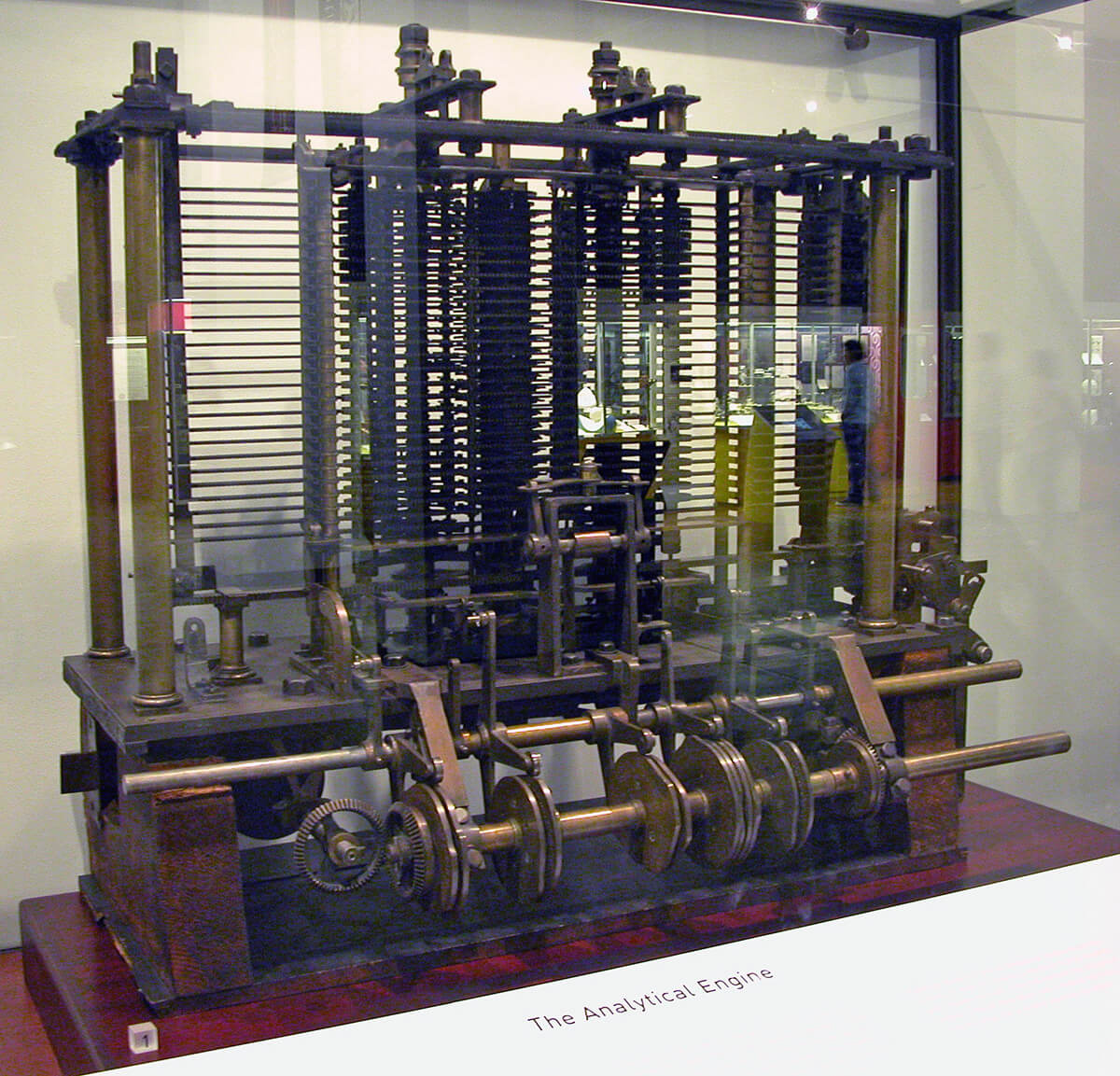
Reconstruction of Babbage’s Analytical Engine, the first general-purpose programmable computer (image courtesy www.wikipedia.com)
The ability to easily calculate large numbers helped drive ever larher and more complex feats of engineering, which in turn required even more powerful calculators. These mechanical computers and calculators were built all the way up through the 1960s before being displaced by electronic calculators and emerging digital computers at the beginning of the digital age.
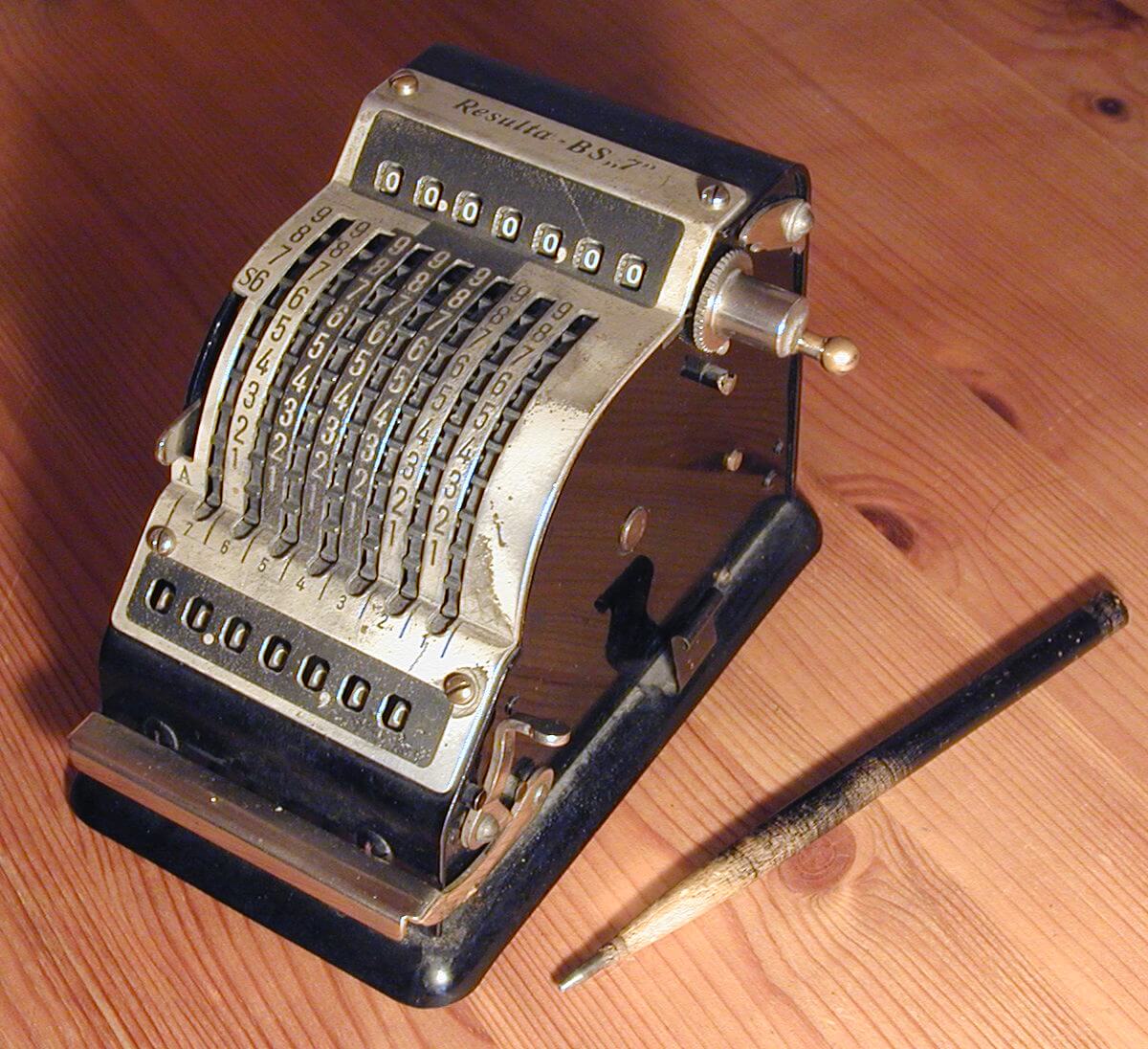
An early (though then “cutting edge”) and tiny (at the time), mechanical calculator. No batteries to charge, no need for WiFi . . . just like a mechanical watch
The old is not lost on the youth
There have been recent inventions and attempts at using mechanical computers for very specific tasks that eliminate the possible software bugs. The largest (and I mean physically largest) mechanical computer that I am aware of is in the Long Now 10,000 Year Clock Orrery ,which is still under construction. It uses a multi-layer binary calculation engine comprising eight layers of pins, levers, and Geneva cross gears (also known as Maltese crosses) to calculate and display the movement of the sun and five planets − Mercury, Venus, Earth, Mars and Jupiter − visible to the human eye.
Quantième Perpétuel à Équation
That mechanical computer is actually quite similar to another that found its way into a much smaller timepiece, the Greubel Forsey Quantième Perpétuel à Équation. This watch houses Greubel Forsey’s seventh invention, the Computeur Mécanique (mechanical computer), a miniature perpetual calendar and equation of time calculator, which is a complete departure from the traditional perpetual calendar mechanism.
While it might do what the traditional perpetual calendar does, the Quantième Perpétuel à Équation does it in an entirely different way, utilizing an actual mechanical calculating engine.
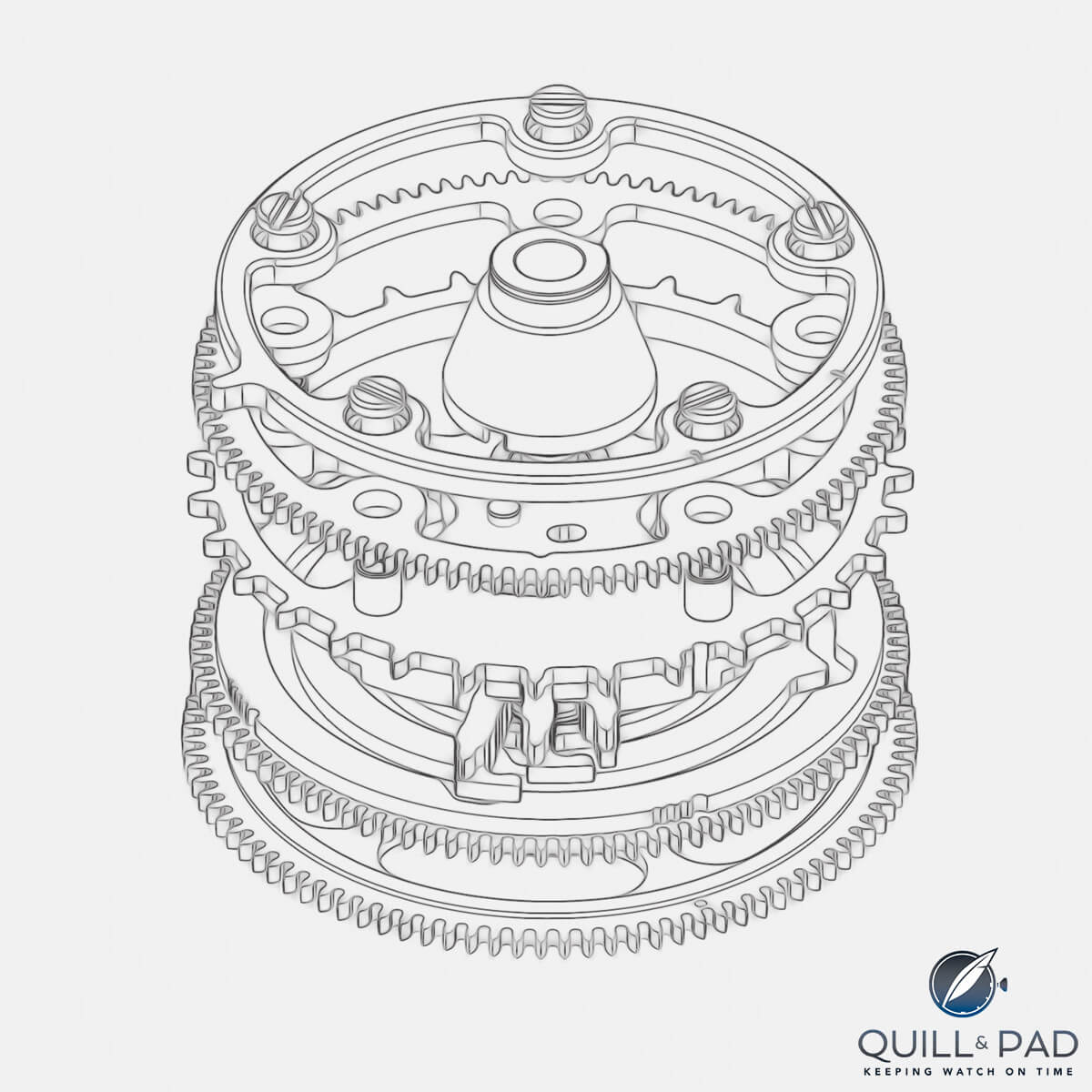
Greubel Forsey’s 7th invention, the Computeur Mecanique (mechanical computer). It isn’t dissimilar to a miniature version of the disks on a rose engine, which rotate to produce different patterns
Greubel Forsey’s mechanical computer is a system of 25 parts that interacts with the gear train to control six different displays.
The computeur mécanique is a relatively simple system, but one with an incredible amount of complexity built into it. To show the progression of the date, days, months, years, and equation of time, it – like the calculating engine in the Long Now orrery – has multiple wheels that are “programmed” (or designed) to interact with the others in a very specific way.
Usually this will be like an aggregator, with a single tooth (or possibly multiple teeth) driving the entire system. Similar systems work like this: an input is made from the turning of a wheel, which changes the position of a secondary wheel. This position will either allow or not allow a pin/tooth/lever to change its position as the following wheel advances . . . ad infinitum.
Each wheel has different numbers and positions of teeth/pins/levers so that after a wheel makes a full cycle, it will reset itself. When combining ratios and a finite number of positions for the parts, almost any calculation can be achieved with enough wheels and enough steps in the machine.
Mystery Making Magic
Since Greubel Forsey’s computeur mécanique has several patents pending, it isn’t yet clear how it works exactly. In reality, though, even the nerdiest among us might end up with our eyes glazed over at a detailed explanation.
But upon scanning the exploded view of the subassembly, we at least find some clues. One sees multiple wheels with a variety of teeth,some are connected via screws, and all of them share a central axis. One has a single tooth, and extending from the middle of the assembly is a set of three fingers, very possibly for successive year changes with a final “open” condition for the mechanical computer.
Or not.
Undoubtedly, all of these wheels mesh with other gears of varying styles, which allow them to interact in some way.
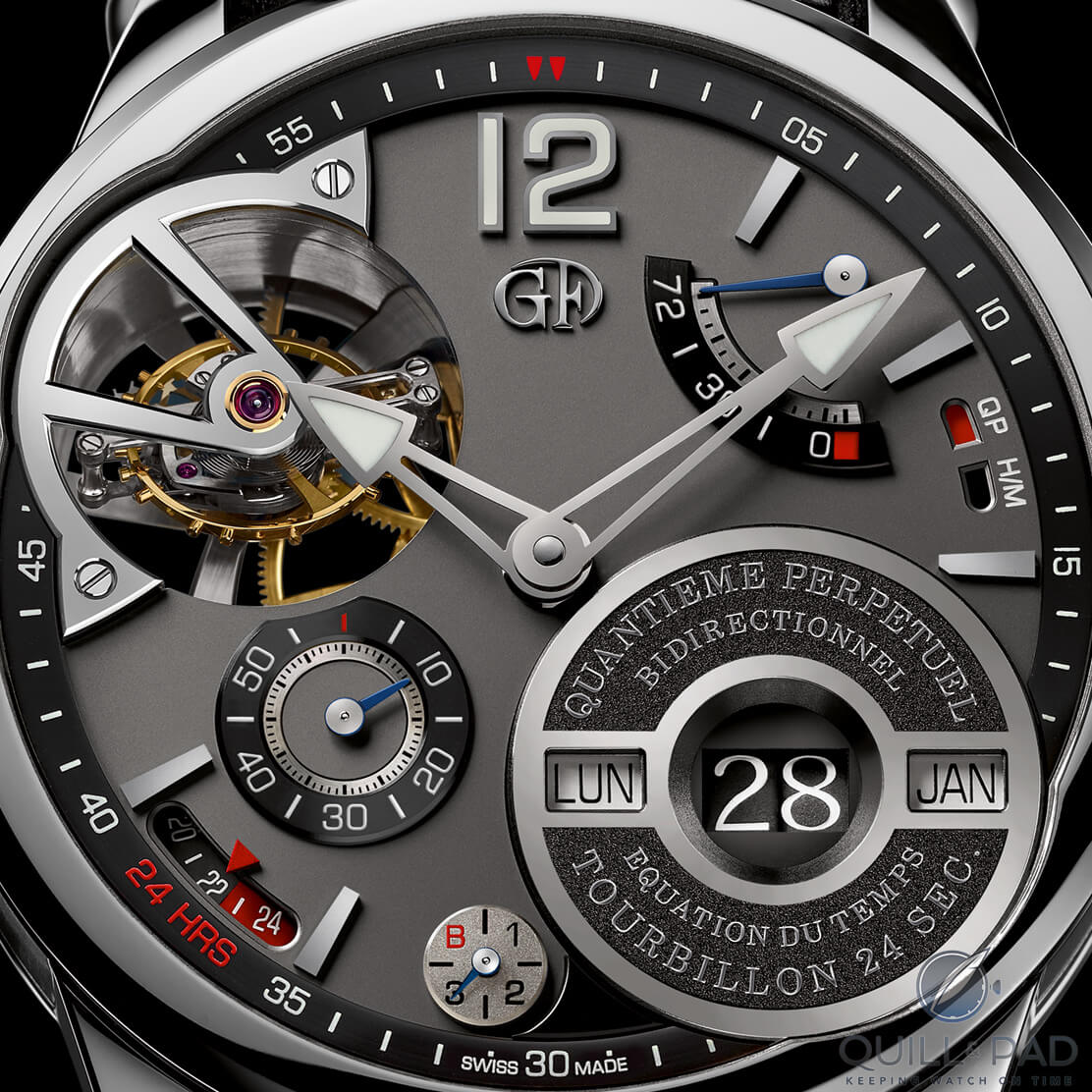
Close up of the dial of the Greubel Forsey Quantième Perpétuel à Équation. At 6 o’clock you can see the small indication for the leap year (B for bisextile, which is French for leap year). To the left of that is a 24-hour display, with areas in red (around midnight) indicating that it isn’t possible to set the calendar
But that isn’t where the magic ends. The computeur mécanique is responsible for eight indications, four on the front and four on the rear of the movement. On the front we have the perpetual calendar date, day, and month in a beautiful and easy-to-read package. Flanking this group on the left at six o’clock is the leap year indication, which connects straight through to the rear of the movement where the indication also drives the digital year display. The central axis for each might actually be shared, and if not, then driven by neighboring gears.
Also on the rear is the equation of time with the season, solstice, and equinox display. The equation of time has its own sapphire disk, while the season, solstice, and equinox are on a second sapphire disk directly below that.
Since the seasons, solstices, and equinoxes are all tied to each other based on the calendar, they can be grouped into a single display.
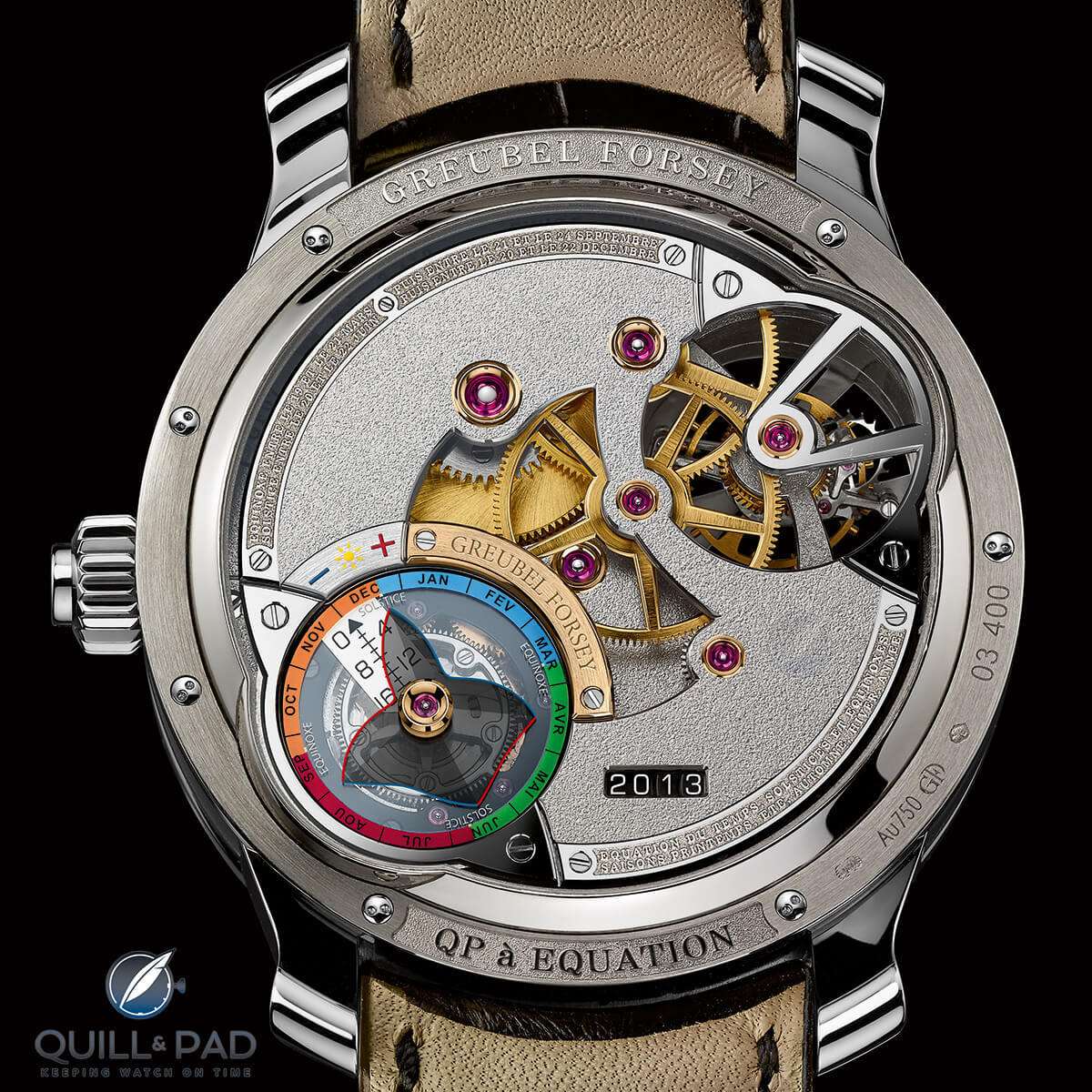
View through the display back of the Greubel Forsey Quantième Perpétuel à Équation. The Equation of Time “manta ray” and display is at 8 o’clock with the year beside, and the back of the 25-degree inclined 24-second tourbillon can be seen under the polished bridge at 2 o’clock
The equation of time disk, and its manta ray-esque indication, move at a slightly different rate than the calendar year and pass over a graduated scale starting at zero and descending to sixteen. These are the minutes of apparent solar time (where the sun actually is in the sky), ahead or behind mean solar time, which is the time that your watch keeps (after adjustment for time zones).
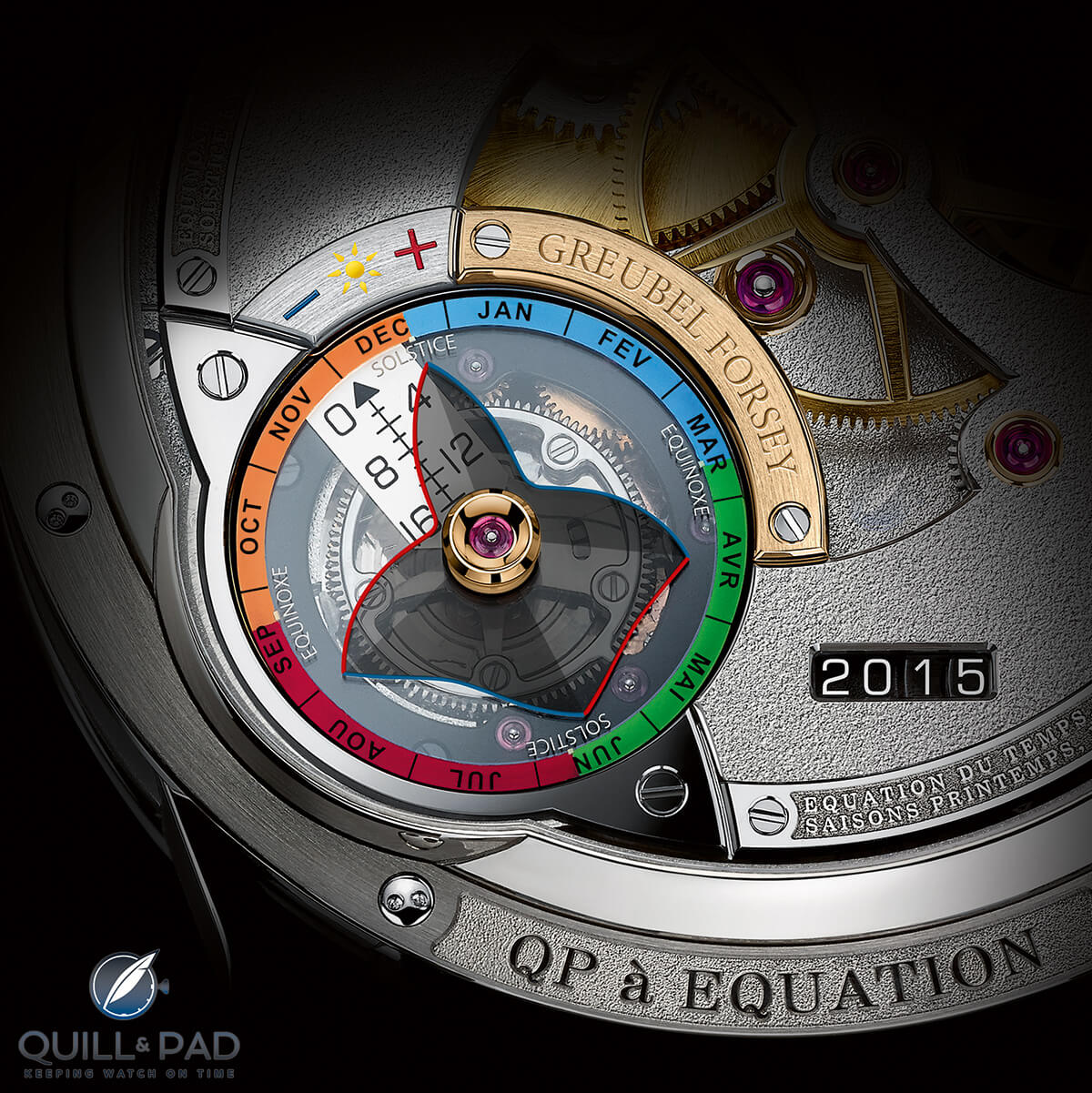
A close view of the “manta ray” equation of time display on the back of Greubel Forsey Quantième Perpétuel à Équation
The manta ray shape passes over this scale to display the number of minutes that the watch is deviating from apparent solar time. The blue highlighted edges indicate the solar time is earlier than what your watch is reading, and the red edges indicate the time is later. This scale also includes a handy-dandy arrow for pointing to the approximate place in the month and also highlights when the solstice and equinox are.
It’s simple! User interaction perfected
So how do you change all of these indications, along with the time, forward and backward? With the crown, silly!
This is probably where the true genius comes to the forefront. Greubel Forsey has created a rather complicated mechanical computer that can be adjusted forward and backward due to the incredible simplicity of its construction.
The great thing about mechanical computers (if they are built intelligently) is that they are mainly aggregators that work from A to B in cyclical fashion, which means if you run them backward they simply count backward as they undo the steps that came before.
The computeur mécanique allows for this when setting all the indications via the crown. Thanks to a push-button selector, the crown can be switched from time setting to perpetual calendar setting (with a corresponding indicator on the dial) making for easy adjustments. No need to press any tiny adjusters in the side of the case with a pin; you can simply set it and go.
The dial even has a 24-hour indicator between 7 and 8 o’clock, making it clear with a highlighted red section between the hours of the date change where you do not want to adjust the mechanism. And there is a safety mechanism so that you cannot make an adjustment if it might cause damage to the movement.
Rounding out the dial are the hours, minutes, small seconds, and power reserve indication.
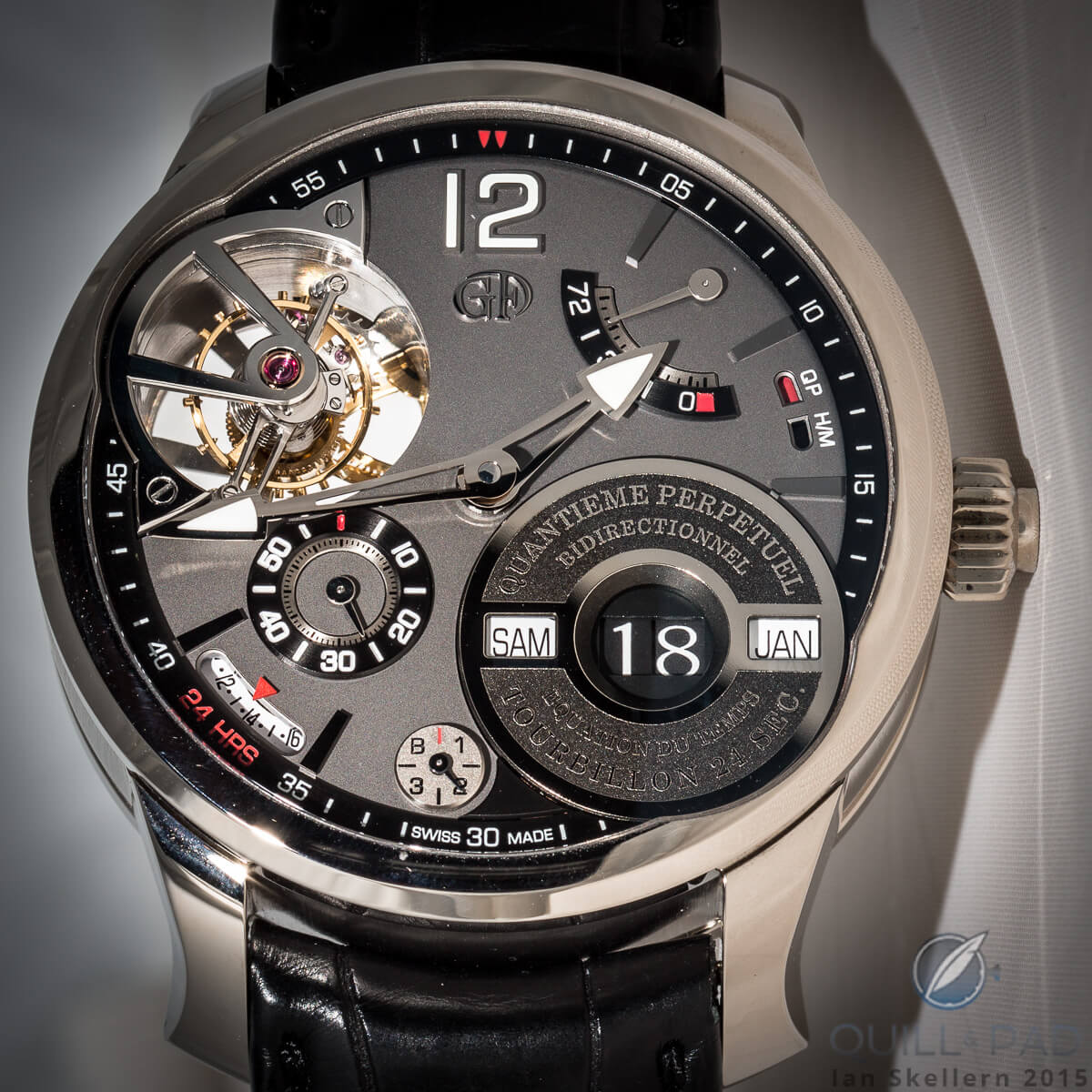
Greubel Forsey Quantième Perpétuel à Équation. Note the ease of reading day, (big) date and month in a straight line
Oh, and it wouldn’t be a Greubel Forsey without an inclined tourbillon, in this case a 25-degree inclined 24-second tourbillon.
For a Greubel Forsey design, this watch actually keeps it pretty tame. Not as tame as the new Vision Tourbillon 24 Secondes (see Give Me Five! Tourbillons From SIHH 2015) or any of the Secret models, but tame by Greubel Forsey standards.
Regardless, it is packed with tons of engineering and weeks (probably months) of hand finishing. The Quantième Perpétuel à Équation holds up as another excellent model, and one of the most complicated pieces by the boutique brand to date.
Okay, that’s actually a hard thing to quantify with the extent of Greubel Forsey’s inventions and the sheer awesomeness with which the duo approaches every project. Hmm, I may be beginning to sound a bit biased . . . nah.
I absolutely love this piece, its design, and all the technical treasures hidden (or not-so-hidden) inside. It definitely shows a commitment to excellence and the desire to pursue new and probably better ways to do things. I recommend giving it a deeper look, and thinking about the changes that the brand is making at the edges of groundbreaking horology. I think you will be as pleased as I am.
The only good way to rate the Greubel Forsey Quantième Perpétuel à Équation is with the Nerd-Writer Quotient. For this model, the calculation goes as follows:
Number of movement components (570) ÷ number of indications the computeur mécanique controls (8) ÷ period of the tourbillon in seconds (24)
Nerd-Writer Quotient of the Greubel Forsey Quantième Perpétuel à Équation
- 570 ÷ 8 ÷ 24 = 3Ξ
For more information, please visit www.greubelforsey.com.
Quick Facts Greubel Forsey Quantième Perpétuel à Équation
Case: 43.5 x 16 mm, white gold
Movement: manually wound caliber based upon Greubel Forsey’s seventh invention with 24-second tourbillon at a 25-degree incline
Functions: hours, minutes, seconds; 24-hour indicator, power reserve; perpetual calendar with day, date, month, digital year, leap year; equation of time, season, solstice, equinox
Price: 670,000 Swiss francs
Trackbacks & Pingbacks
-
[…] might also enjoy: Mechanical Computers From Then To Now: Greubel Forsey Quantième Perpétuel à Équation and Our Predictions In The Calendar Category Of The 2017 Grand Prix d’Horlogerie de Genève: We […]
-
[…] You might also enjoy: Mechanical Computers From Then To Now: Greubel Forsey Quantième Perpétuel à Équation. […]
Leave a Reply
Want to join the discussion?Feel free to contribute!

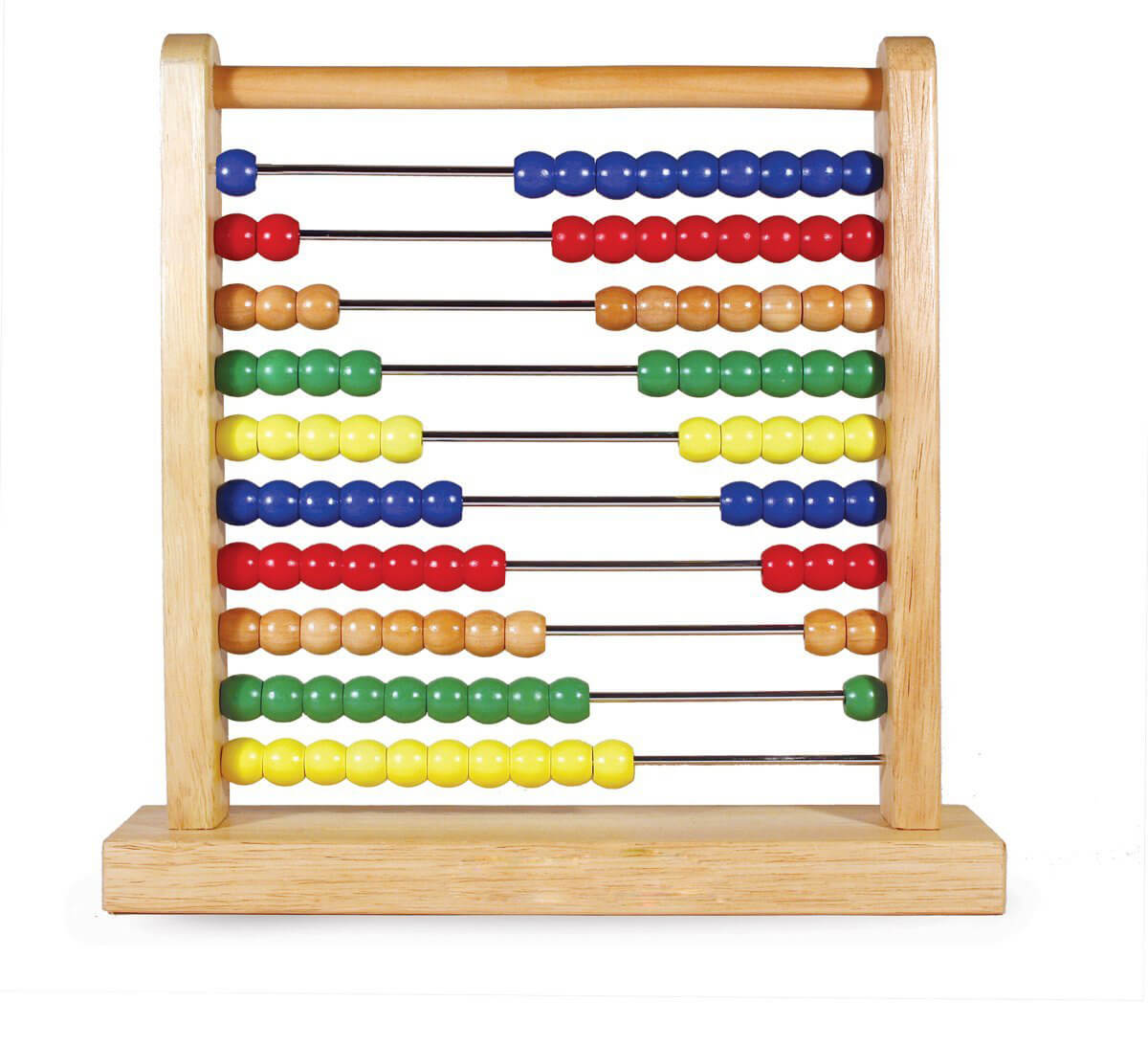
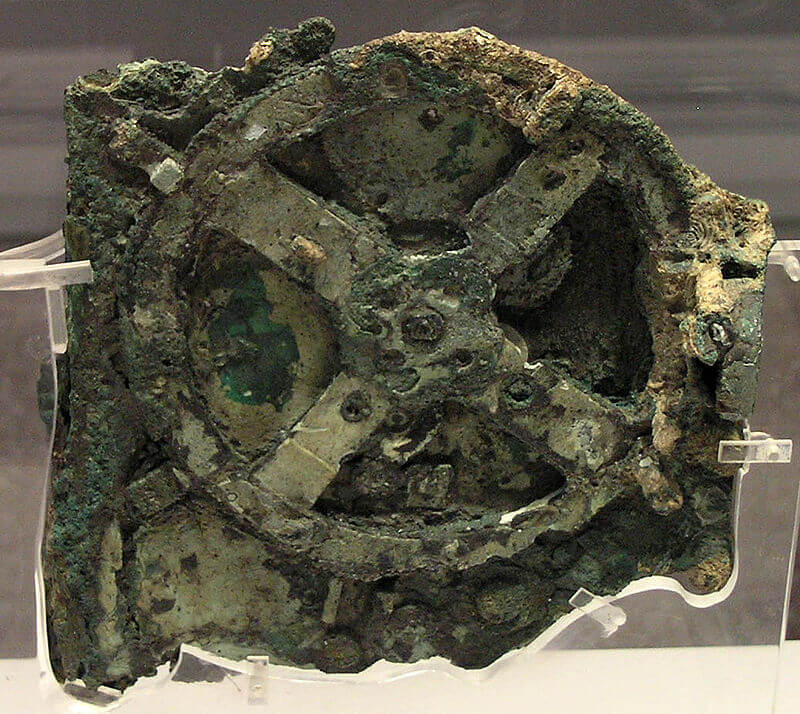
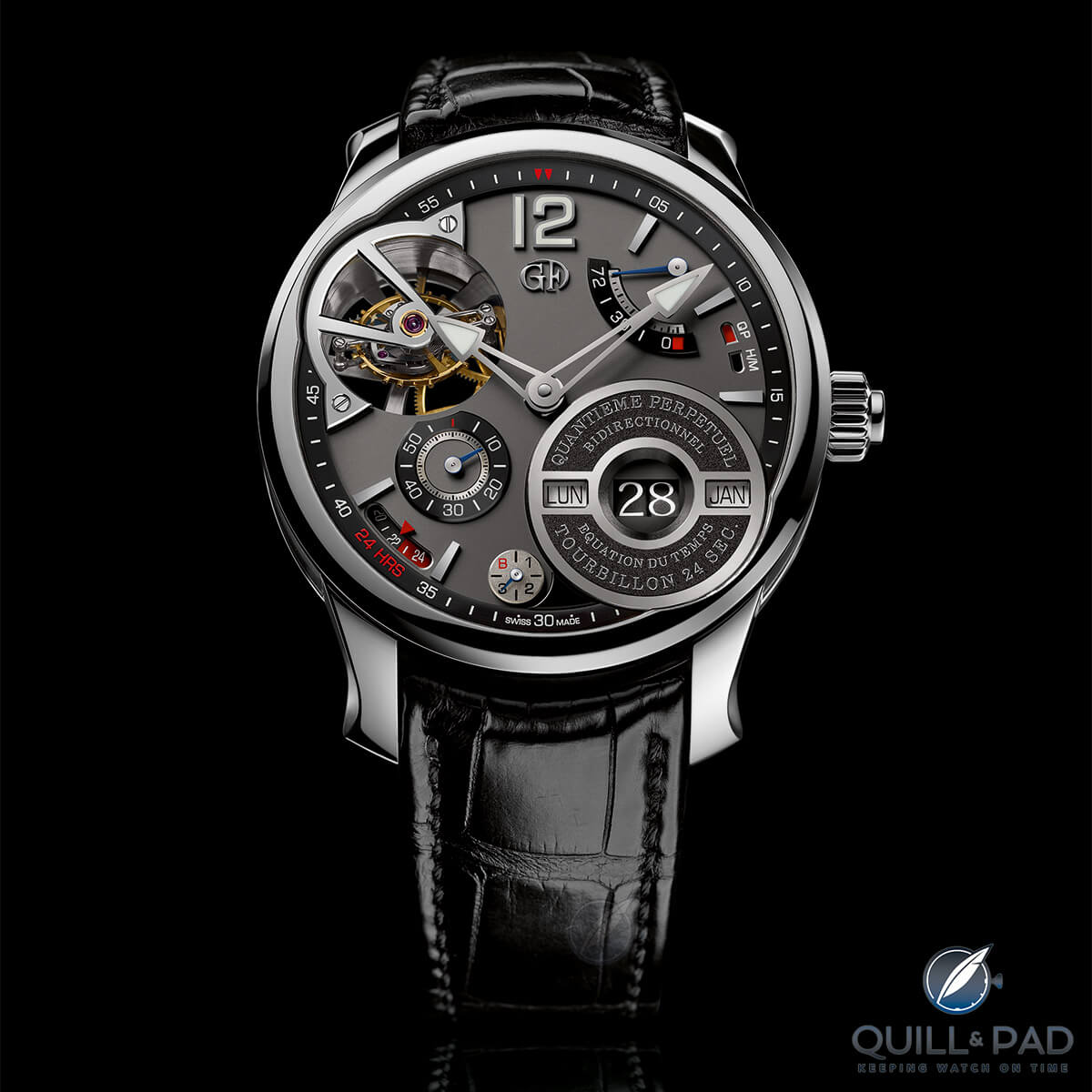
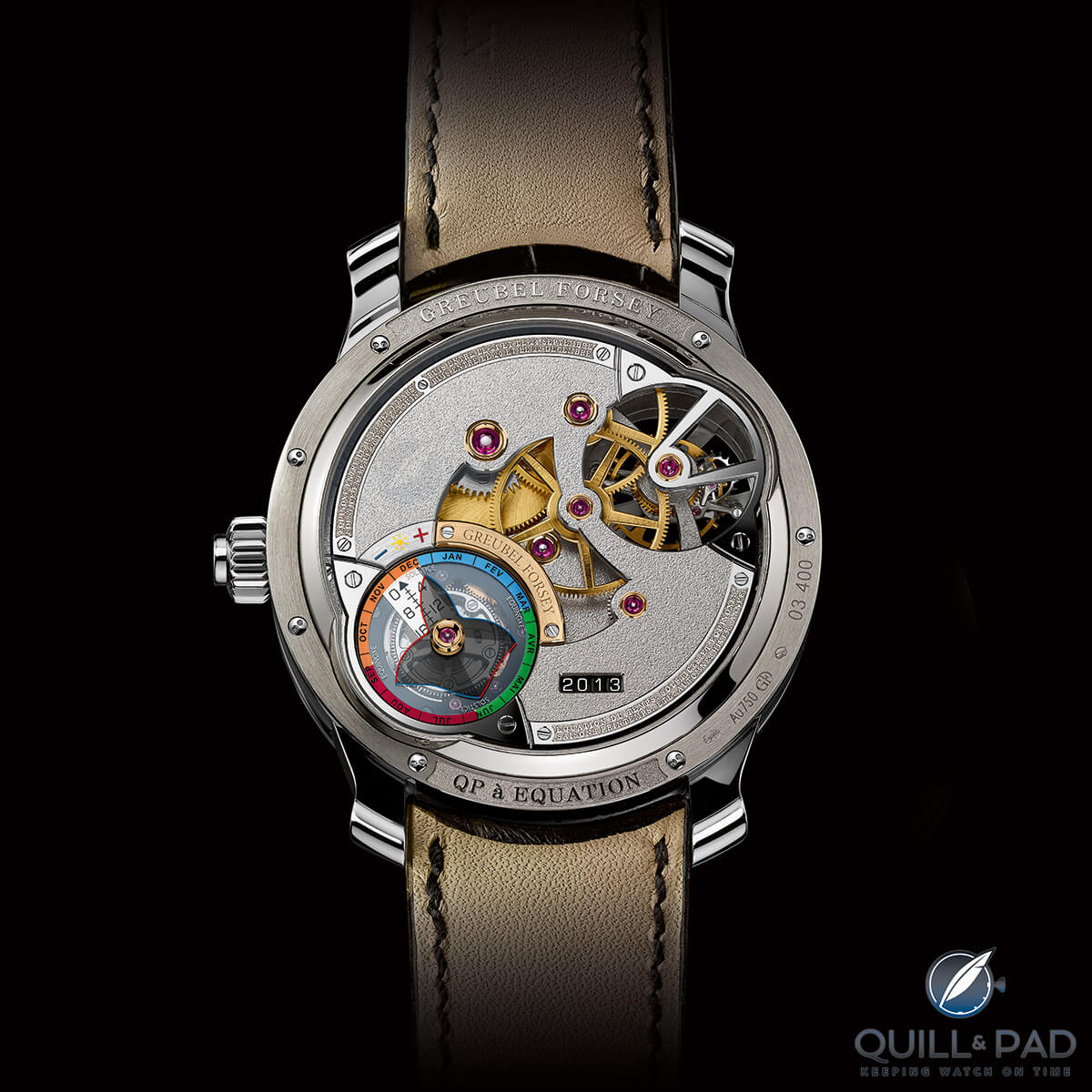
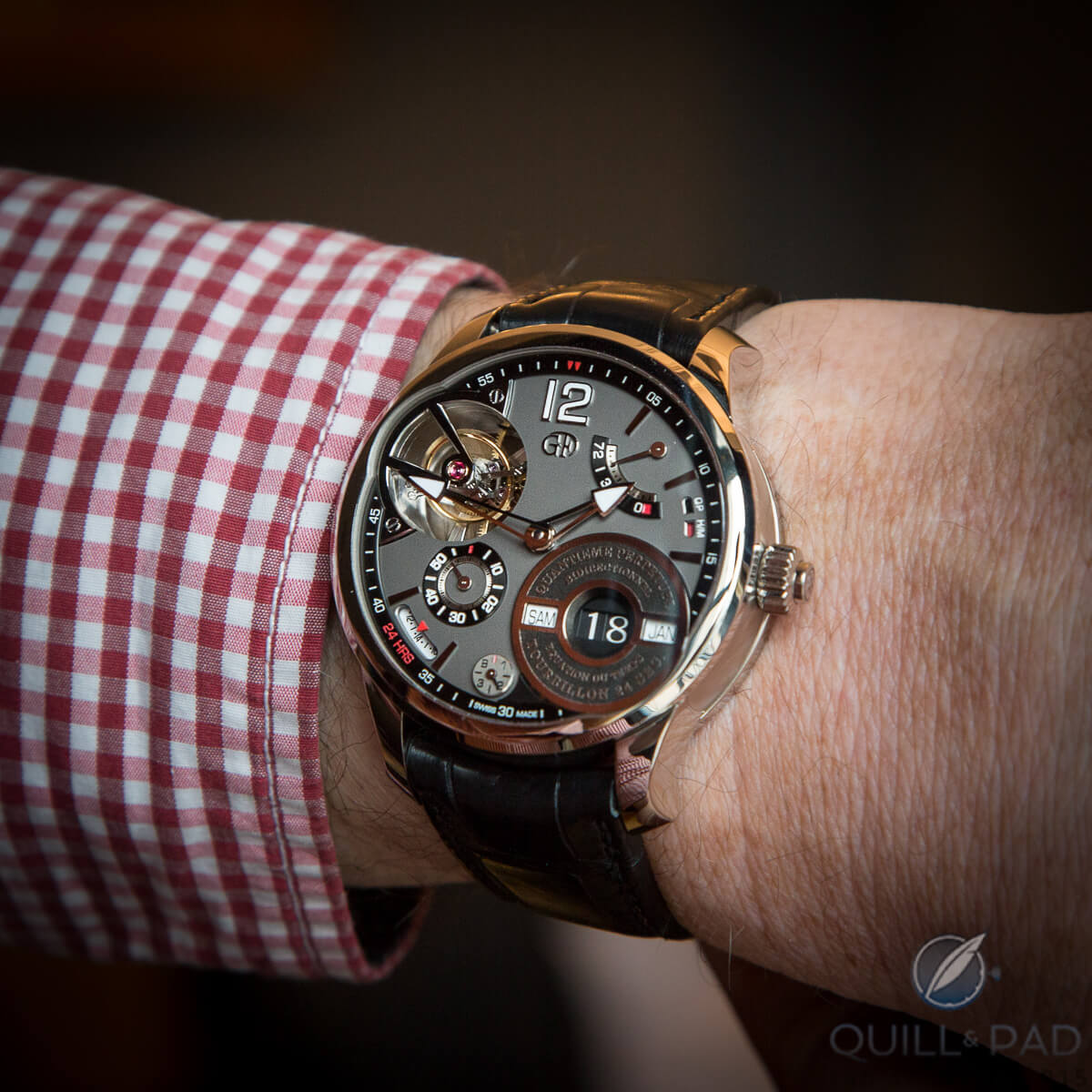
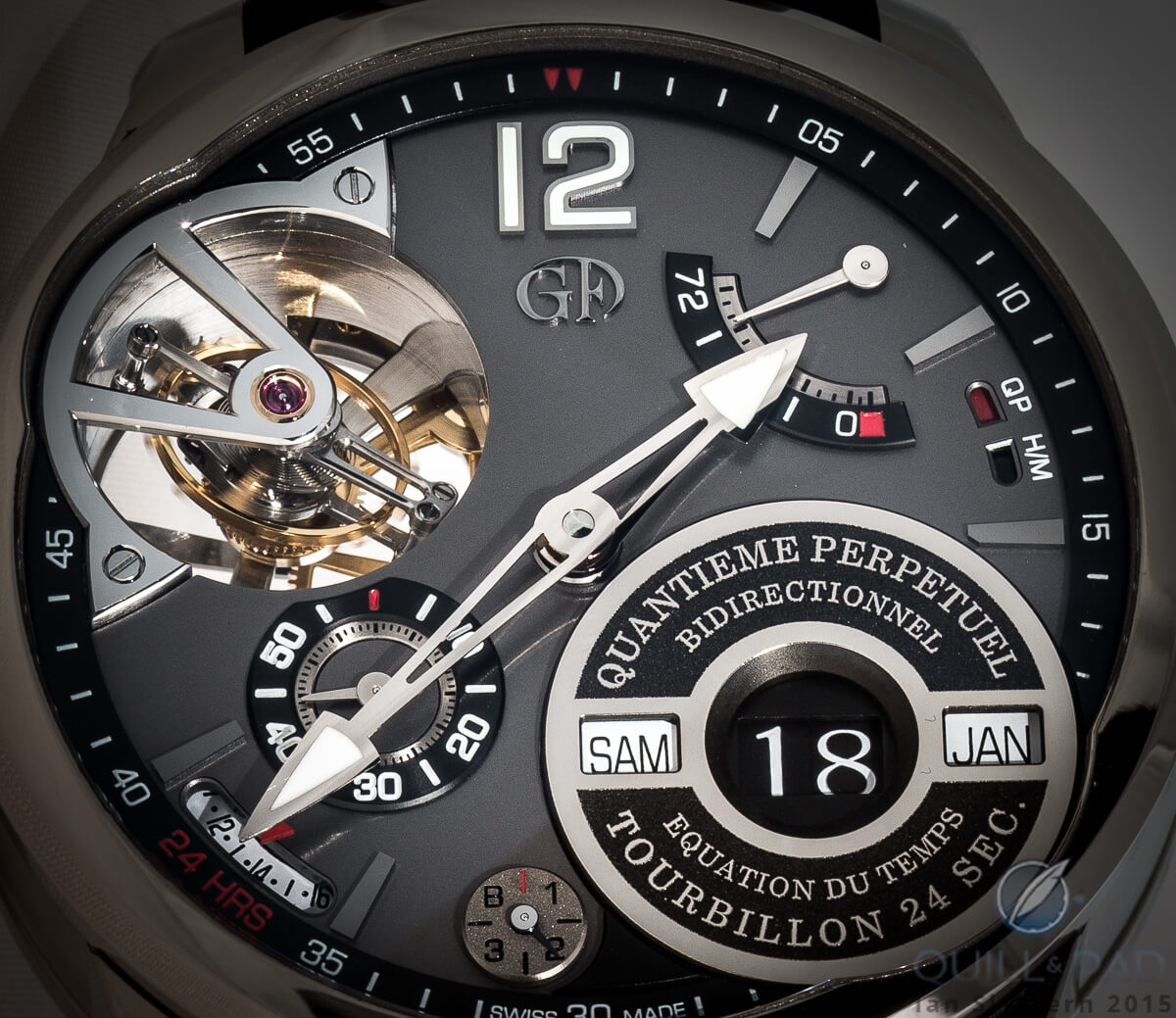
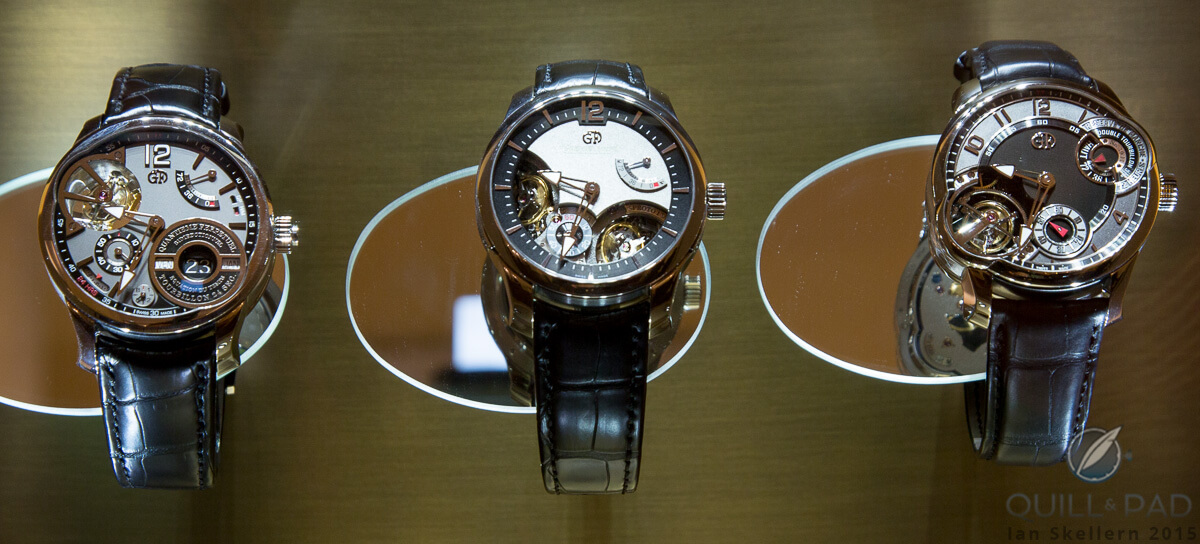
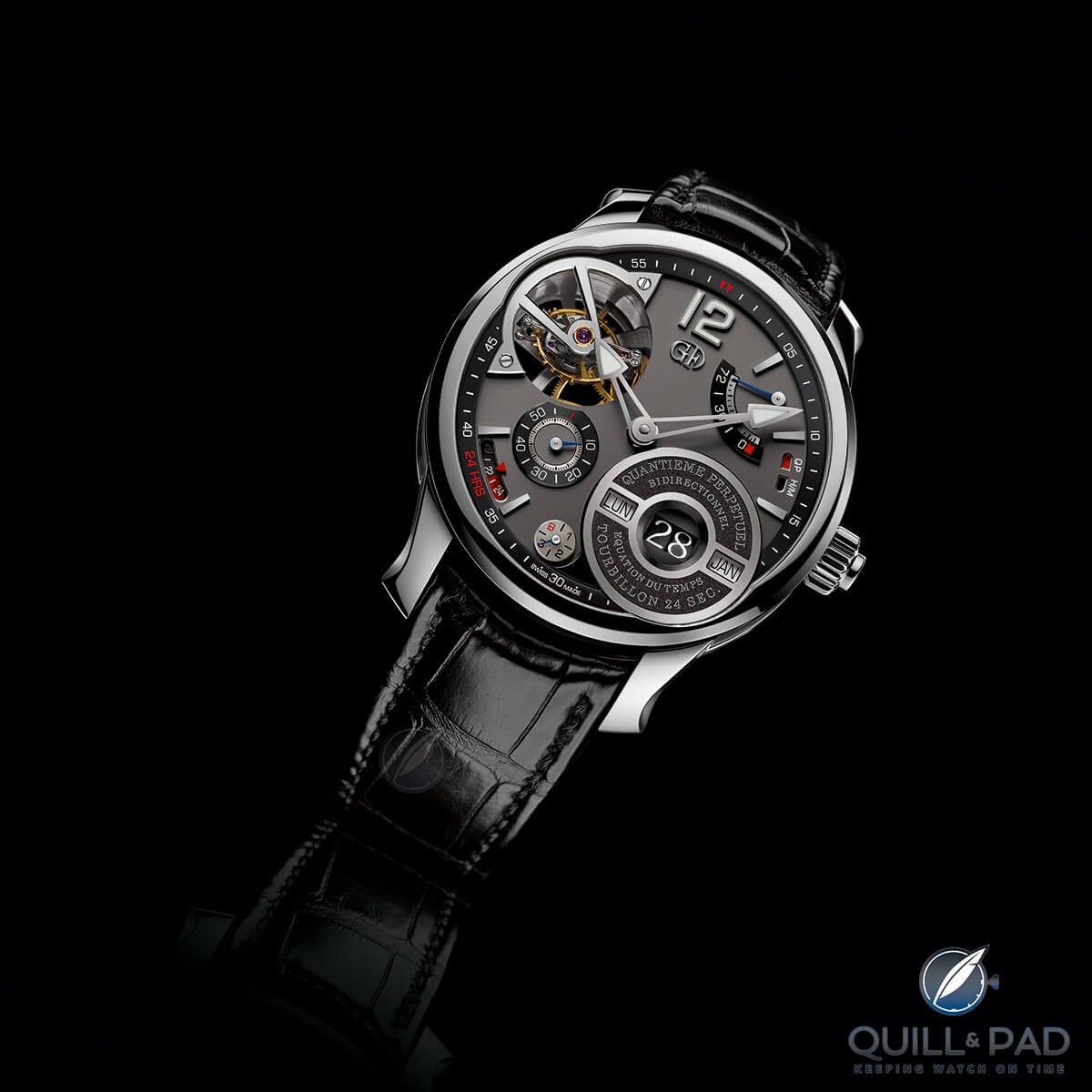


It’s surprising to find on quillandpad.com a resource so precious about equations.
We will note your page as a benchmark for Mechanical Computers
From Then To Now: Greubel Forsey Quantième Perpétuel à Équation .
We also invite you to link and other web resources for
equations like http://equation-solver.org/ or https://en.wikipedia.org/wiki/Equation.
Thank you and good luck!
Excellent article, really enjoyed reading it…the Greubel Forsey QP à Équation is an absolute masterpiece!
It deserves the Aiguille d’Or.